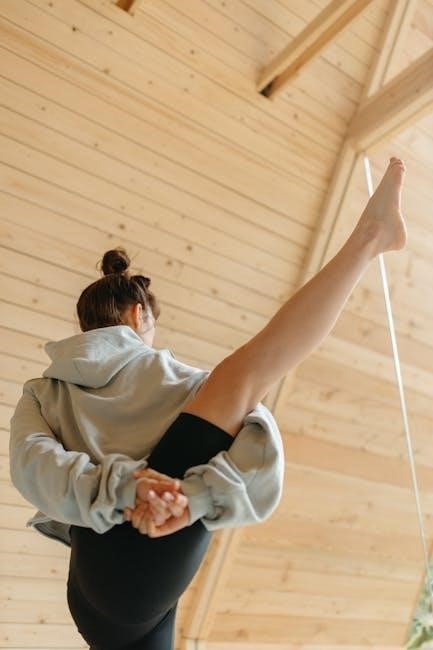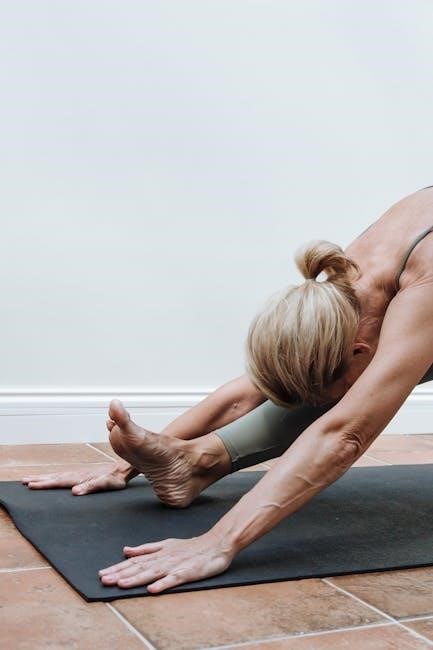Hip mobility exercises are essential for improving flexibility, strength, and overall joint health. Limited mobility can lead to stiffness, pain, and reduced athletic performance. By incorporating stretching, strengthening, and dynamic movements, these exercises enhance range of motion and support daily activities. Whether you’re recovering from injury or aiming to boost fitness, hip mobility routines offer tailored solutions for all levels. Consistent practice promotes long-term benefits, ensuring optimal hip function and reducing the risk of future issues.
1.1 Importance of Hip Mobility
Hip mobility is essential for maintaining proper movement patterns, preventing injuries, and enhancing athletic performance. Limited hip mobility can lead to lower back pain, poor posture, and muscle imbalances. Engaging in regular hip mobility exercises improves flexibility, strengthens surrounding muscles, and promotes better joint health. Neglecting hip mobility can result in reduced range of motion and increased risk of injuries during physical activities.

1.2 Brief Overview of Hip Anatomy
The hip joint is a ball-and-socket joint, connecting the femur (thigh bone) to the pelvis. It consists of the acetabulum (socket) and the femoral head. Surrounding muscles, such as the gluteus medius and minimus, piriformis, and hip flexors, play a crucial role in movement and stability. Proper hip anatomy is essential for facilitating activities like walking, running, and squatting, while poor alignment or muscle imbalances can lead to discomfort and mobility issues.

Types of Hip Mobility Exercises
Hip mobility exercises are categorized into three main types: stretching exercises, strengthening exercises, and dynamic mobility exercises, each targeting different aspects of hip function and flexibility.
2.1 Stretching Exercises
Stretching exercises focus on improving hip flexibility and reducing muscle tension. Techniques like the prone quad stretch and kneeling hip stretch target the hip flexors and glutes. These exercises enhance range of motion, alleviate tightness, and promote relaxation. Regular stretching can prevent stiffness and improve overall mobility, making daily activities and athletic performance more efficient. Incorporating these stretches into a routine helps maintain healthy hip function and reduces injury risk.
2.2 Strengthening Exercises
Strengthening exercises target the muscles around the hips to improve stability and power. The clam exercise and fire hydrants are effective for building hip strength. These exercises engage the gluteus medius and other stabilizers, enhancing joint stability. Regular strengthening helps prevent muscle imbalances, improves athletic performance, and supports overall hip health. Incorporating these exercises into your routine promotes better movement patterns and reduces the risk of injury, ensuring strong and functional hips for daily activities and sports.
2.3 Dynamic Mobility Exercises
Dynamic mobility exercises combine movement and stretching to enhance hip flexibility and strength. These exercises, like Gate Pose Hip Hinges and Kneeling Hip Circles, involve controlled, flowing motions that prepare the body for physical activity. They improve balance, coordination, and range of motion while reducing stiffness. Regular practice promotes better joint function and enhances overall athletic performance, making them a key component of a comprehensive hip mobility routine for active individuals and athletes alike.
Stretching Exercises for Hip Mobility
Stretching exercises improve hip flexibility and reduce stiffness. Techniques like the prone quad stretch and kneeling hip stretch target key muscles, enhancing range of motion and comfort in movement.

3.1 Prone Quad Stretch
Lie on your stomach and pull your heel toward your glutes with the same-side arm. Hold for 20 seconds. For focus on hip flexors, place a towel roll under the hip bone. This stretch improves flexibility and reduces stiffness in the quadriceps and hip flexors, enhancing overall hip mobility and posture. Regular practice helps maintain range of motion and prevents tightness.
3.2 Kneeling Hip Stretch
Begin in a half-kneeling position, with one knee on the ground and the other foot flat in front of you. Gently push your hips forward until you feel a stretch in the front of the hip of the back leg. Hold for 20-30 seconds and switch sides. This stretch targets the hip flexors and improves flexibility, reducing tightness and enhancing mobility. Regular practice helps maintain proper hip alignment and movement.
Strengthening Exercises for Hip Mobility
Strengthening exercises target hip muscles to improve stability and power. Clam exercises and fire hydrants are effective for engaging glutes and hip abductors, enhancing overall mobility and function.
4.1 Clam Exercise
The clam exercise targets the gluteus medius and hip abductors. Lie on your side with knees bent and feet touching. Slowly lift the top knee while keeping feet together, then lower. This strengthens hip stability and prevents imbalances. Perform 3 sets of 15-20 reps on each side for optimal results. Proper form ensures effectiveness and minimizes injury risk.
4.2 Fire Hydrants
Fire Hydrants are a dynamic strengthening exercise targeting the glutes and hip abductors. Start on all fours with hands under shoulders and knees under hips. Engage your core, lift one leg outward while maintaining a 90-degree bend in the knee and hip. Avoid rotating the hips or arching the back. Aim to lift the thigh to hip level and hold briefly before lowering. Perform 3 sets of 10-15 reps on each side to enhance hip strength and stability.
Dynamic Hip Mobility Routine
Dynamic hip mobility routines combine movement and flexibility to enhance joint function. Exercises like leg swings, lunges, and hip circles improve range of motion and prepare for activity.
5.1 10-Minute Mobility Routine
A 10-minute mobility routine can significantly improve hip flexibility and strength. Begin with leg swings to loosen the hips, followed by bodyweight squats to engage the glutes. Incorporate side-lying hip abductions to target the outer hip muscles. Conclude with seated forward folds to stretch the hamstrings and lower back. This efficient routine requires no equipment and can be done daily to enhance mobility and reduce stiffness.

5.2 Gate Pose Hip Hinge
The Gate Pose Hip Hinge is a dynamic exercise that enhances hip mobility and strength. Start in a standing position with feet shoulder-width apart. Bend at the hips, keeping your back straight, and swing one leg backward while hinging forward slightly. Alternate sides to engage both hips. This movement improves flexibility and activates the glutes and hamstrings, promoting better range of motion and reducing stiffness in the hip joint.
Pilates for Hip Mobility
Pilates offers targeted exercises to enhance hip mobility through controlled movements and core engagement. It improves flexibility, strength, and alignment, promoting fluid hip motion and reducing stiffness.
6.1 Clam Exercise in Pilates
The clam exercise in Pilates targets the glutes and hip muscles, enhancing lateral hip mobility. Lie on your side with knees bent, lift the top knee without moving the feet, and hold. This movement strengthens the gluteus medius, improving hip stability and alignment. Perform 10-15 repetitions on each side for optimal results. It’s a low-impact, effective exercise for better hip function and posture.
6.2 Side-Lying Hip Abduction
The side-lying hip abduction is a Pilates exercise that strengthens the hip abductors, improving mobility and stability. Lie on one side with legs straight, lift the top leg while keeping it straight, then lower slowly. This movement targets the gluteus medius, enhancing hip function and reducing the risk of injury. Perform 10-15 repetitions on each side for optimal results. It’s a simple yet effective exercise for better hip alignment and strength.

Yoga Flow for Hip Opening
Yoga flow for hip opening combines gentle stretches and flowing movements to release tension and improve flexibility. It targets tight hip muscles, enhancing mobility and reducing stiffness, promoting relaxation and overall well-being through mindful breathing and controlled poses.
7.1 Kneeling Hip Circles
Start on hands and knees, with core engaged. Slowly move hips in large circles, first clockwise, then counterclockwise. Focus on hip movement, not lower back. Keep knees bent at 90 degrees. Perform 5-8 repetitions in each direction. This exercise improves hip mobility and balance. Gradually increase circle size as flexibility allows. Regular practice enhances joint health and reduces stiffness, promoting smoother, more controlled movements in daily activities and sports.
7.2 Seated Forward Fold
Sit on the floor with legs extended straight. Inhale, lengthen spine, then exhale, folding forward from hips, reaching for toes or shins. Keep knees slightly bent if needed. Hold for 20-30 seconds, breathing deeply. Repeat 2-3 times. This stretch targets hip flexors, hamstrings, and lower back, relieving tightness and improving flexibility. Modify by placing a towel under hips for support if necessary. Regular practice enhances hip mobility and reduces stiffness.

Daily Practice and Consistency
Daily practice is crucial for improving hip mobility. Consistency ensures lasting benefits, such as enhanced flexibility and reduced stiffness. Incorporate exercises into your routine, even briefly, to maintain progress and prevent regression. Regular practice strengthens muscles and improves joint health, making daily movements easier and less painful over time.

8.1 Benefits of Regular Practice
Regular hip mobility practice offers numerous benefits, including improved joint flexibility, reduced muscle stiffness, and enhanced athletic performance. Consistent routines strengthen surrounding muscles, providing better support and stability. Over time, this can alleviate pain, prevent injuries, and promote better posture. Daily exercises also boost blood flow, aiding in recovery and maintaining optimal hip function. By committing to regular practice, individuals can enjoy long-term mobility and overall well-being.
8.2 Tips for Incorporating Exercises into Daily Routine
Start with short, manageable sessions, like 5-10 minutes daily, using a yoga mat. Schedule exercises around your routine, such as after waking up or before bed. Combine mobility work with strength training for efficiency. Gradually increase intensity as fitness improves. Track progress with a printable PDF guide. Consistency is key to maintaining hip health and preventing stiffness. Make it a habit to prioritize these exercises for long-term benefits.

Avoiding Common Mistakes
Avoid overstretching and lifting legs too high, as this can cause strain or injury. Ensure proper form by engaging core muscles and avoiding back arching. Use mirrors to monitor alignment and reduce risks. Preventing these errors enhances safety and effectiveness of hip mobility exercises, promoting better outcomes and long-term joint health.
9.1 Overstretching and Injury Prevention
Overstretching can lead to hip instability and injury. Avoid bouncing during stretches, as it may cause microtears. Hold stretches for 20-30 seconds to safely improve flexibility. Strengthening exercises, like clam shells and fire hydrants, help stabilize the hip joint. Warm up before starting and focus on controlled, gradual movements. Proper form prevents strain, while progressive overload ensures balanced development. Prioritize low-impact exercises to protect vulnerable tissues and maintain joint integrity.
9.2 Importance of Proper Form
Maintaining proper form during hip mobility exercises prevents injuries and ensures effectiveness. Misalignment can strain muscles or joints, leading to pain or poor results. Engage core muscles to stabilize the body and focus on slow, controlled movements. Avoid arching the back or rotating hips excessively, as seen in exercises like fire hydrants. Correct technique targets the intended muscles, maximizing benefits while minimizing risks. Guidance from professionals or instructional resources can help master proper form and achieve optimal outcomes.
Hip mobility exercises are crucial for maintaining joint health, reducing pain, and enhancing movement. Regular practice improves flexibility and strength, promoting overall well-being. Start your journey today!
10.1 Summary of Key Points
Hip mobility exercises are essential for improving flexibility, strength, and joint health. They enhance range of motion, reduce pain, and prevent injuries. Regular practice promotes better posture, athletic performance, and overall well-being. By incorporating stretching, strengthening, and dynamic movements, these exercises cater to all fitness levels. Consistency is key to maintaining long-term benefits and ensuring optimal hip function for years to come.
10.2 Encouragement to Start the Practice
Starting a hip mobility practice is simpler than you think! Even small, consistent efforts can yield significant improvements. Begin with short routines, like the 10-minute mobility sequence, to build confidence and strength. Remember, every movement counts, and patience will lead to lasting results. Embrace the journey to better hip health and enjoy the freedom of pain-free, fluid motion in your daily life.